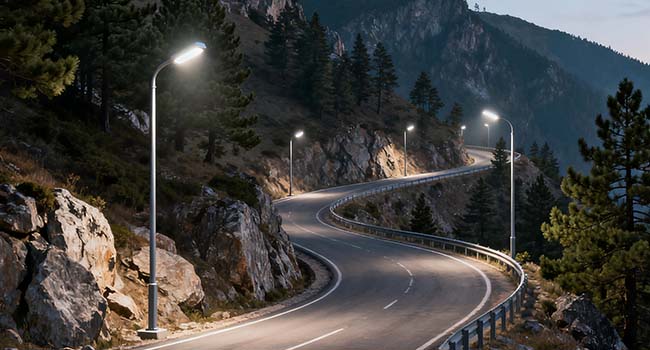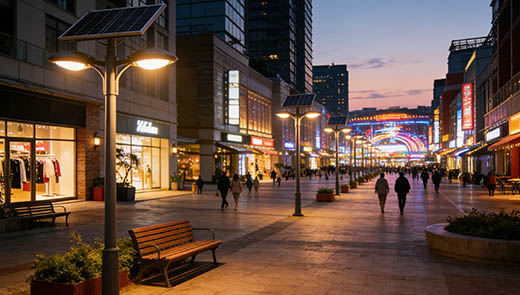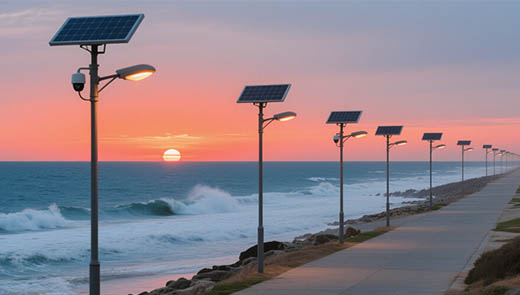What Are The Common LED Street Lighting Problems and Solutions?
LED street lights have become the mainstream choice for urban roads, parks, and township lighting due to their core advantages of energy efficiency, long lifespan, and high brightness. Their application scale continues to expand alongside urbanization. However, in actual use, various factors such as component quality, design processes, and installation environments often lead to malfunctions. These issues not only reduce lighting effectiveness and compromise travel safety but also increase operational and maintenance costs. This article systematically outlines the eight most common LED street light issues, provides in-depth analysis of their causes, and offers proven solutions to help industry practitioners and procurement teams avoid pitfalls.

LED Driver Power Supply Failures
Common Causes
Use of low-cost, substandard drivers with poor voltage regulation and unstable output, failing to meet LED street light operational requirements. Defective heat dissipation design causing excessive operating temperatures, accelerating internal component aging and shortening lifespan. Grid voltage surges (e.g., lightning strikes) or circuit faults causing internal circuit breakdown, resulting in sudden LED street light shutdowns.
Solutions
Select drivers from premium brands like Philips to ensure superior quality and stability, effectively meeting long-term operational demands. Prioritize drivers with built-in over-temperature protection and surge protection to withstand harsh grid conditions. Choose drivers with conversion efficiency ≥90% and a design life ≥50,000 hours to reduce replacement frequency and maintenance costs.
Poor LED Chip Quality
Common Causes
Using unbranded, low-cost generic chips with inferior materials and manufacturing processes leads to rapid degradation, causing significant brightness reduction within one to two years of operation. Chips lack rigorous color sorting, resulting in large color variations within the same batch—excessively yellow or blue hues—compromising road illumination comfort. Low luminous efficiency means insufficient brightness at equivalent power consumption, causing severe energy waste and undermining energy-saving objectives.
Solutions
Select chips from reputable brands like Epistar or Seoul Semiconductor for more controllable quality, ensuring stable LED street light performance. Choose chips with luminous efficacy no less than 160lm/W to balance brightness and energy efficiency. Require suppliers to provide chip reports, guaranteeing consistent LED light color with color temperature deviation controlled within 300K to enhance lighting experience.
Insufficient IP/IK Protection Ratings
Common Causes
Low IP ratings (e.g., IP54 or below) fail to effectively block rain and dust ingress, causing internal circuit short-circuits. Low IK ratings (e.g., IK06 or below) indicate insufficient housing strength, leading to damage from minor impacts and compromising internal component safety. Uncoated housing materials corrode in coastal or high-humidity environments, shortening overall lifespan.
Solutions
|
Protection Requirement |
Recommended Rating |
Suitable Scenarios |
|
Waterproof & Dustproof |
IP65 / IP66 |
Urban roads, campuses, and general outdoor areas |
|
Impact Resistance |
IK08 / IK10 |
Main roads, parking lots, and collision-prone areas |
|
Corrosion & Rust Protection |
Marine-grade aluminum |
Coastal areas, high-humidity zones, industrial regions |
Poor Heat Dissipation Design
Common Causes
Unoptimized heat sink design with insufficient surface area and compact structure prevents effective heat conduction and dispersion, causing heat buildup within the luminaire. LED street light housings made of materials with low thermal conductivity, such as plastic, exhibit poor heat transfer efficiency, hindering heat dissipation. Installation environments with inadequate ventilation—such as enclosed light poles—or failure to optimize heat dissipation designs for high-temperature regions result in persistently elevated operating temperatures.
Solutions
Adopt die-cast aluminum housings. Aluminum's high thermal conductivity (approximately 237 W/(m·K)) provides significantly superior heat dissipation compared to plastic or iron casings, enabling rapid transfer of heat generated by the luminaire. Increase the surface area of heat sinks or employ perforated or finned heat dissipation structures to enhance heat exchange efficiency. Select high-temperature-resistant chips with a junction temperature tolerance of no less than 125°C to meet the operational demands of LED street lights in high-temperature environments.

Poor Powder Coating Quality
Common Causes
Using low-cost powder coatings with weak UV resistance leads to aging, cracking, and peeling after prolonged sun exposure. Failure to perform pre-treatment like sandblasting or degreasing on the LED luminaire housing before spraying results in poor coating adhesion and easy flaking. Coatings failing to meet industry standards exhibit insufficient corrosion resistance in salt spray or humid environments, causing rust on the LED luminaire housing.
Solutions
Select high-quality UV-resistant and salt-spray-resistant powder coatings like polyester powder to enhance housing weather resistance. Require sandblasting pretreatment of LED street light housings before coating to ensure adhesion, with cross-hatch adhesion tests meeting Grade 1 or higher. Choose coating products compliant with ISO 12944 and ASTM D1654 standards to extend the anti-corrosion lifespan of LED street light housings.
Unsuitable Light Distribution Design
Light distribution design determines the illumination effect of LED street lights. Optimal distribution achieves demand-based lighting—ensuring uniform road surface brightness without noticeable dark zones, bright spots, or glare that impairs driver or pedestrian visibility. Improper design severely compromises lighting quality and user experience.
Common Causes
Using inexpensive aspherical lenses causes severe light scattering, preventing precise control of light direction. Improper beam angle selection—such as narrow beams on wide roads—results in mismatched coverage and uneven illumination. Lack of cutoff structures allows direct light to strike pedestrians' and drivers' eyes, creating glare that compromises safety.
Solutions
Employ precision optical lenses like TIR lenses to achieve precise light control in LED street lights, minimizing light waste. Select appropriate beam angles based on road width to enhance lighting uniformity. Install glare shields or cutoff structures to keep the UGR glare value below 19, ensuring travel safety.
|
Road Type |
Recommended Beam Angle |
Suitable LED Street Light Scenario |
|
Sidewalks, Alleys |
Type II – 25° |
Small LED street lights, low power |
|
Residential Roads, Branch Roads |
Type III – 40° |
Medium LED street lights, medium power |
|
Main Roads, Secondary Roads |
Type IV – 60° |
Large LED street lights, high power |
|
Highways |
Type V – 120° |
Highway-specific LED street lights |
Low Luminous Efficiency
Energy efficiency is one of the core advantages of LED street lights. Luminous efficiency—measured in lumen per watt (lm/W)—represents the amount of light emitted per unit of power consumed and serves as a key indicator for evaluating a street light's energy-saving performance. If a street light's luminous efficiency is too low, it will consume excessive electricity without providing adequate illumination, failing to leverage its energy-saving benefits and increasing electricity costs.

Common Causes
The overall luminous efficacy of the LED street light is below 100 lm/W, falling short of industry standards and resulting in poor energy efficiency. Low driver conversion efficiency causes electrical energy to be wasted as heat rather than being effectively converted into light energy. Poor optical design means the proportion of effective light—light that actually illuminates the road surface—is low, leading to insufficient light utilization.
Solutions
Select products with overall luminous efficacy of at least 130 lm/W for more significant energy savings. Pair with drivers boasting conversion efficiency of 90% or higher to reduce power loss and enhance energy utilization. Optimize reflector and lens designs to achieve effective light utilization rates of 85% or higher, directing more light onto target road surfaces.
Light Flickering
Common Causes
Unstable driver output current causes LED lamp chips to flicker intermittently. Grid voltage fluctuations—such as during peak usage hours—can overwhelm drivers lacking voltage stabilization, leading to flickering. Poor-quality internal components like capacitors and resistors degrade rapidly, triggering LED lamp flickering.
Solutions
Select drivers with constant current accuracy within ±3% to ensure stable current output and prevent flickering. Install voltage stabilizers for LED street lights in areas with significant grid fluctuations to guarantee power supply stability. Adopt no PWM dimming technology to eliminate flickering at low brightness levels.
Common issues with LED street lights often stem from poor component quality, sub optimal design, and inadequate protection. By rigorously controlling the quality of core components—drivers and chips—during procurement, focusing on critical design aspects like protection, heat dissipation, and optical distribution, and performing routine maintenance, failures can be significantly reduced. This approach fully leverages the energy efficiency, longevity, and high brightness advantages of LED street lights.




